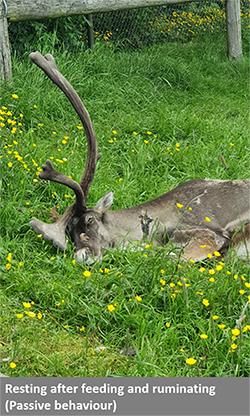Background

What is environmental enrichment?
Various methods to improve animal welfare by increasing behavioural diversity and normal behaviour patterns while also reducing abnormal behaviour, increasing positive utilization of the environment, and increasing the ability to cope with challenges in a more normal way.
It is one of the most important tools to improve the welfare of captive animals. By providing environmental enrichment, effective management practices for zoo animals can be established.
Environmental enrichment can be subdivided into different types: food enrichment, structural enrichment, sensory enrichment, social enrichment, cognitive enrichment, and human-animal interaction. In the present study, I presented the reindeer with food enrichment, sensory enrichment (olfactory), and cognitive enrichment (tactile).
Choosing the appropriate enrichment:
So far, little is known about environmental enrichment for captive reindeer. However, studies on environmental enrichment for other ungulate species show to have a positive effect on the animals’ welfare.
Reindeers‘ diet varies quite a bit between seasons. However, they mostly consume graminoids, lichen, moss, and shrubs. The reindeer in the present study feed on what their outdoor enclosure provides, which is grass and sometimes tree leaves, as well as hay and reindeer moss that is provided by the keepers. Therefore, presenting the reindeer with food enrichment could enhance their diet and show us what type of food they prefer.
Reindeer have a sensitive sense of smell, which they strongly rely on for tracking and locating food, and chemical communication. When presented, olfactory enrichment could increase their foraging behaviour, resulting in higher activity levels.
They shed their winter fur and their velvet during the summer and autumn, these reindeer have been seen to rub against the fence to help with the shedding process. Tactile enrichment may be attractive to the reindeer and could be used to speed up the shedding process in a safe way.
Aims
The aim of this study was to present a group of zoo-housed reindeer with three different types of environmental enrichment: food, olfactory, and tactile enrichment, to assess their response towards each type of enrichment and to assess if it has a positive effect on their behaviour.
Responsible for this page:
Director of undergraduate studies Biology
Last updated:
05/26/21
